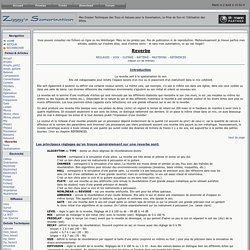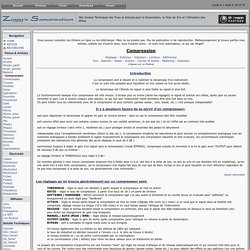

Fiche Technique. Vous pouvez consultez ces fichiers en ligne ou les télécharger.

Mais ne les piratez pas. Pas de publication ni de reproduction. Malheureusement je trouve parfois mes articles, publiés sur d'autres sites, sous d'autres noms - et sans mon autorisation, ce qui est illegal!! Reverbe RÉGLAGES - VOIX - GUITARE - BATTERIE - MASTERING - RÉFÉRENCES (cliquer sur les thèmes) Introduction La reverbe sert à la spatialisation du son. Elle sert également à soutenir ou définir une certaine couleur sonore. La reverbe est la somme d'une multitude d'échos qui sont renvoyés par les différents obstacles que rencontre le son (les murs, le sol ,les meubles ou même les arbres ou des falaises de roches etc.). On peut produire une reverbe très basique avec une pédale de delay (écho) en réglant le temps de retard sur 200 msec et le feedback de manière à avoir trois à quatre répétitions. La couleur et la richesse d'une reverbe produite par un processeur dépend évidemment de la qualité (et souvent du prix!)
Fiche Technique. Vous pouvez consultez ces fichiers en ligne ou les télécharger.

Mais ne les piratez pas. Pas de publication ni de reproduction. Malheureusement je trouve parfois mes articles, publiés sur d'autres sites, sous d'autres noms - et sans mon autorisation, ce qui est illegal!! Compression Réglages - Schémas - Sidechain - Limiteur - Références Voix - Batterie - Basse - Guitare - Cuivres et Autres - Mastering - Sidechain (cliquez sur un thème) Introduction La compression sert à réduire et à maîtriser la dynamique d’un instrument.
La dynamique est l’étendu du signal le plus faible au signal le plus fort. Le fonctionnement basique d’un compresseur est très simple. Il y a plusieurs façons de se servir d'un compresseur: soit pour régulariser la dynamique et gagner en gain et volume sonore - dans ce cas la compression doit être inaudible soit comme effet pour avoir une certaine couleur sonore (le son variété américain, le son pub etc.) et où l'effet est au contraire très audible retour sommaire.
The Ultimate EQ Cheat Sheet for Every Common Instrument. Image via Shutterstock You asked, and you shall receive, Sonicbids blog readers.

Per multiple requests, here's my guide to, "When the hell do I start turning these knobs, and where do they go? " But before we begin, I offer you the fine print: These references are general ideas for where to begin to look for sonic issues with particular sounds, instruments, and voices. I'm not going to tell you "always notch this 9 dB here and add 3 dB here with a wide boost and, voila, perfect sound! " because it's unfortunately just not that simple. Sometimes a guitar cab gets mic'd up differently night to night, plus every voice is unique, and every snare drum "speaks" differently (just ask a drummer). A subtractive approach to EQ Not everyone's ethos on EQ is the same, and most people may never see eye to eye on EQ approach. Also, a quick note on the topic of high pass filters: use them. 5 Tips for Mixing Background Vocals.
I’ve received a few requests to cover the topic of mixing background vocals.

Below is a question I received from a member. HELLO !!! Can you make a video talking more about Mixing Background Vocals (R&B). How to EQ them so that they sit good with the Lead Vocal, what Reverb I should use, technique about Panning them (especially when you’ve Got a lot of backing vocals) and Compression technique.
I think there is not enough tutorials focusing on it. To be honest I can totally understand. The truth is though, the quicker I got to a minimalist approach the better my background vocals sounded. The only time I would really put a lot of emphasis on the background vocals is if the song was EXTREMELY vocal driven, like an Accapella or a ballad with few instruments. Now when I refer to background vocals in this article I am talking about vocals stacks like harmonies or over dubs; anything that accompanies the performance and not a riff or ad lib.
5 Tips for Mixing Background Vocals.